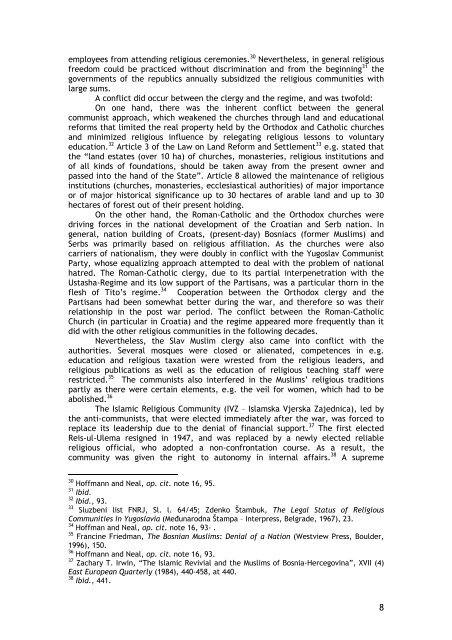Theory and practice of human Rights and minority rights ... - EURAC
Theory and practice of human Rights and minority rights ... - EURAC
Theory and practice of human Rights and minority rights ... - EURAC
You also want an ePaper? Increase the reach of your titles
YUMPU automatically turns print PDFs into web optimized ePapers that Google loves.
employees from attending religious ceremonies. 30 Nevertheless, in general religious<br />
freedom could be <strong>practice</strong>d without discrimination <strong>and</strong> from the beginning 31 the<br />
governments <strong>of</strong> the republics annually subsidized the religious communities with<br />
large sums.<br />
A conflict did occur between the clergy <strong>and</strong> the regime, <strong>and</strong> was tw<strong>of</strong>old:<br />
On one h<strong>and</strong>, there was the inherent conflict between the general<br />
communist approach, which weakened the churches through l<strong>and</strong> <strong>and</strong> educational<br />
reforms that limited the real property held by the Orthodox <strong>and</strong> Catholic churches<br />
<strong>and</strong> minimized religious influence by relegating religious lessons to voluntary<br />
education. 32 Article 3 <strong>of</strong> the Law on L<strong>and</strong> Reform <strong>and</strong> Settlement 33 e.g. stated that<br />
the “l<strong>and</strong> estates (over 10 ha) <strong>of</strong> churches, monasteries, religious institutions <strong>and</strong><br />
<strong>of</strong> all kinds <strong>of</strong> foundations, should be taken away from the present owner <strong>and</strong><br />
passed into the h<strong>and</strong> <strong>of</strong> the State”. Article 8 allowed the maintenance <strong>of</strong> religious<br />
institutions (churches, monasteries, ecclesiastical authorities) <strong>of</strong> major importance<br />
or <strong>of</strong> major historical significance up to 30 hectares <strong>of</strong> arable l<strong>and</strong> <strong>and</strong> up to 30<br />
hectares <strong>of</strong> forest out <strong>of</strong> their present holding.<br />
On the other h<strong>and</strong>, the Roman-Catholic <strong>and</strong> the Orthodox churches were<br />
driving forces in the national development <strong>of</strong> the Croatian <strong>and</strong> Serb nation. In<br />
general, nation building <strong>of</strong> Croats, (present-day) Bosniacs (former Muslims) <strong>and</strong><br />
Serbs was primarily based on religious affiliation. As the churches were also<br />
carriers <strong>of</strong> nationalism, they were doubly in conflict with the Yugoslav Communist<br />
Party, whose equalizing approach attempted to deal with the problem <strong>of</strong> national<br />
hatred. The Roman-Catholic clergy, due to its partial interpenetration with the<br />
Ustasha-Regime <strong>and</strong> its low support <strong>of</strong> the Partisans, was a particular thorn in the<br />
flesh <strong>of</strong> Tito’s regime. 34 Cooperation between the Orthodox clergy <strong>and</strong> the<br />
Partisans had been somewhat better during the war, <strong>and</strong> therefore so was their<br />
relationship in the post war period. The conflict between the Roman-Catholic<br />
Church (in particular in Croatia) <strong>and</strong> the regime appeared more frequently than it<br />
did with the other religious communities in the following decades.<br />
Nevertheless, the Slav Muslim clergy also came into conflict with the<br />
authorities. Several mosques were closed or alienated, competences in e.g.<br />
education <strong>and</strong> religious taxation were wrested from the religious leaders, <strong>and</strong><br />
religious publications as well as the education <strong>of</strong> religious teaching staff were<br />
restricted. 35 The communists also interfered in the Muslims’ religious traditions<br />
partly as there were certain elements, e.g. the veil for women, which had to be<br />
abolished. 36<br />
The Islamic Religious Community (IVZ – Islamska Vjerska Zajednica), led by<br />
the anti-communists, that were elected immediately after the war, was forced to<br />
replace its leadership due to the denial <strong>of</strong> financial support. 37 The first elected<br />
Reis-ul-Ulema resigned in 1947, <strong>and</strong> was replaced by a newly elected reliable<br />
religious <strong>of</strong>ficial, who adopted a non-confrontation course. As a result, the<br />
community was given the right to autonomy in internal affairs. 38 A supreme<br />
30<br />
H<strong>of</strong>fmann <strong>and</strong> Neal, op. cit. note 16, 95.<br />
31<br />
Ibid.<br />
32<br />
Ibid., 93.<br />
33<br />
Sluzbeni list FNRJ, Sl. l. 64/45; Zdenko Štambuk, The Legal Status <strong>of</strong> Religious<br />
Communities in Yugoslavia (Međunarodna Štampa – Interpress, Belgrade, 1967), 23.<br />
34<br />
H<strong>of</strong>fman <strong>and</strong> Neal, op. cit. note 16, 93- .<br />
35<br />
Francine Friedman, The Bosnian Muslims: Denial <strong>of</strong> a Nation (Westview Press, Boulder,<br />
1996), 150.<br />
36<br />
H<strong>of</strong>fmann <strong>and</strong> Neal, op. cit. note 16, 93.<br />
37<br />
Zachary T. Irwin, “The Islamic Revivial <strong>and</strong> the Muslims <strong>of</strong> Bosnia-Hercegovina”, XVII (4)<br />
East European Quarterly (1984), 440-458, at 440.<br />
38<br />
Ibid., 441.<br />
8

















